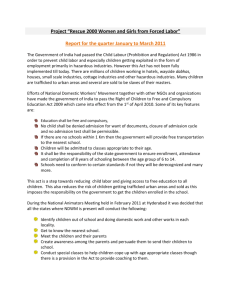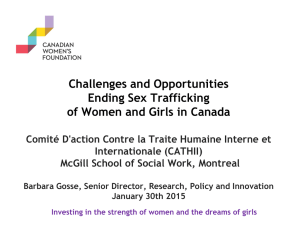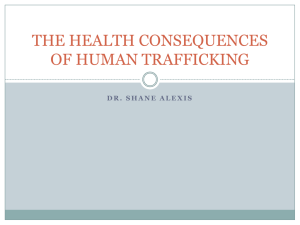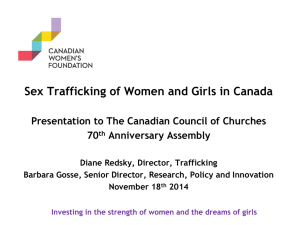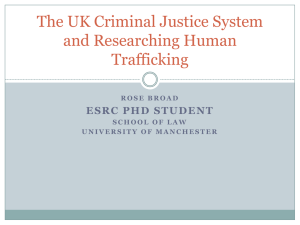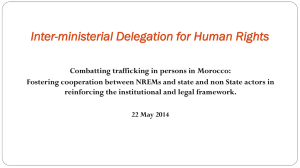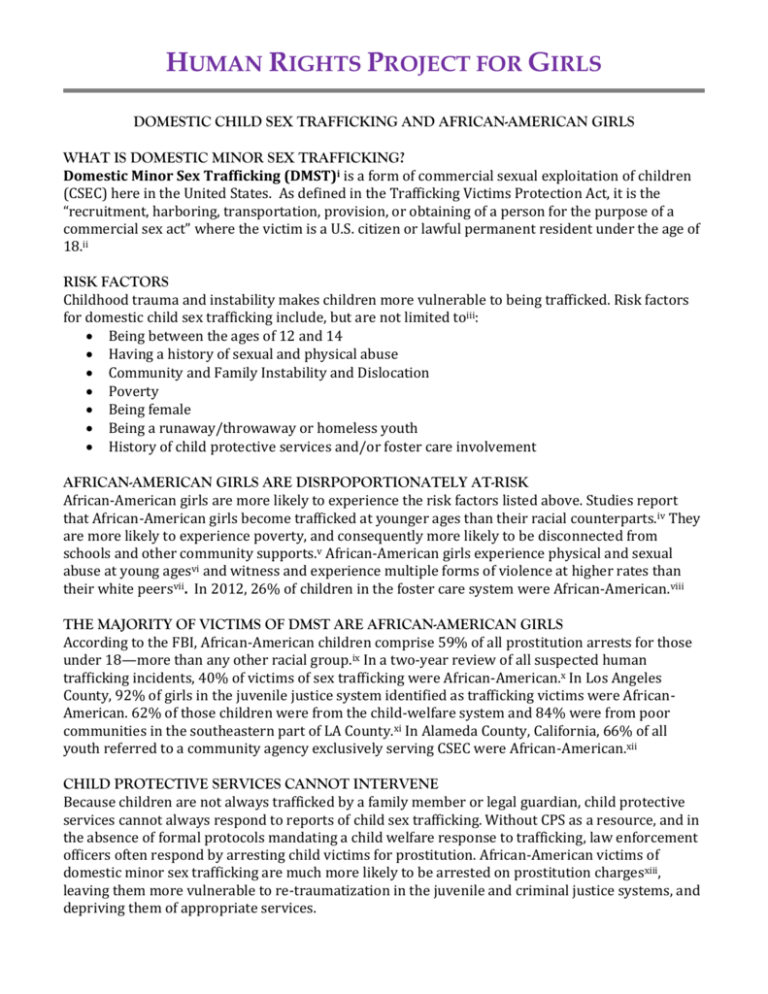
HUMAN RIGHTS PROJECT FOR GIRLS
DOMESTIC CHILD SEX TRAFFICKING AND AFRICAN-AMERICAN GIRLS
WHAT IS DOMESTIC MINOR SEX TRAFFICKING?
Domestic Minor Sex Trafficking (DMST)i is a form of commercial sexual exploitation of children
(CSEC) here in the United States. As defined in the Trafficking Victims Protection Act, it is the
“recruitment, harboring, transportation, provision, or obtaining of a person for the purpose of a
commercial sex act” where the victim is a U.S. citizen or lawful permanent resident under the age of
18.ii
RISK FACTORS
Childhood trauma and instability makes children more vulnerable to being trafficked. Risk factors
for domestic child sex trafficking include, but are not limited toiii:
Being between the ages of 12 and 14
Having a history of sexual and physical abuse
Community and Family Instability and Dislocation
Poverty
Being female
Being a runaway/throwaway or homeless youth
History of child protective services and/or foster care involvement
AFRICAN-AMERICAN GIRLS ARE DISRPOPORTIONATELY AT-RISK
African-American girls are more likely to experience the risk factors listed above. Studies report
that African-American girls become trafficked at younger ages than their racial counterparts.iv They
are more likely to experience poverty, and consequently more likely to be disconnected from
schools and other community supports.v African-American girls experience physical and sexual
abuse at young agesvi and witness and experience multiple forms of violence at higher rates than
their white peersvii. In 2012, 26% of children in the foster care system were African-American.viii
THE MAJORITY OF VICTIMS OF DMST ARE AFRICAN-AMERICAN GIRLS
According to the FBI, African-American children comprise 59% of all prostitution arrests for those
under 18—more than any other racial group.ix In a two-year review of all suspected human
trafficking incidents, 40% of victims of sex trafficking were African-American.x In Los Angeles
County, 92% of girls in the juvenile justice system identified as trafficking victims were AfricanAmerican. 62% of those children were from the child-welfare system and 84% were from poor
communities in the southeastern part of LA County.xi In Alameda County, California, 66% of all
youth referred to a community agency exclusively serving CSEC were African-American.xii
CHILD PROTECTIVE SERVICES CANNOT INTERVENE
Because children are not always trafficked by a family member or legal guardian, child protective
services cannot always respond to reports of child sex trafficking. Without CPS as a resource, and in
the absence of formal protocols mandating a child welfare response to trafficking, law enforcement
officers often respond by arresting child victims for prostitution. African-American victims of
domestic minor sex trafficking are much more likely to be arrested on prostitution chargesxiii,
leaving them more vulnerable to re-traumatization in the juvenile and criminal justice systems, and
depriving them of appropriate services.
HUMAN RIGHTS PROJECT FOR GIRLS
i
Also known as domestic minor sex trafficking
22 U.S.C. §7102(9)
iii
MISSSEY, Framing the Issue of the Commercial Sexual Exploitation of Children (MISSSEY 2009)
http://www.misssey.org/documents/framing_the_issue.pdf; Kate Walker, California Child Welfare
Council, Ending the Commercial Sexual Exploitation of Children: A Call for Multi-System Collaboration
in California (2013), pp.18-20, available at
http://www.youthlaw.org/fileadmin/ncyl/youthlaw/publications/Ending-CSEC-A-Call-for-MultiSystem_Collaboration-in-CA.pdf,
iv
Francine T. Sherman & Lisa Goldblatt Grace, The System Response to the Commercial Sexual
Exploitation of Girls, in Juvenile Justice: Advancing Research Policy, and Practice, 336 (Francine T.
Sherman & Francine H. Jacobs eds., 2011)
v
Lauren Frohlich, Janel George, Fatima Goss Graves, Lara S. Kaufmann, & Leticia Smith-Evans,
NAACP Legal Defense Fund & National Women’s Law Center, Unlocking Opportunity for African
American Girls: A Call to Action for Educational Equity (2014), p.7, available at:
http://www.nwlc.org/sites/default/files/pdfs/unlocking_opportunity_for_african_american_girls_report.pd
f
vi
American Bar Association Commission on Domestic and Sexual Violence, Domestic Violence
Statistiscs
http://www.americanbar.org/groups/domestic_violence/resources/statistics.html#african_americans
vii
National Center for Victims of Crime, Action Partnership on Interventions for Black Children Exposed
to Violence and Victimization, Black Children Exposed to Violence and Victimization
http://www.victimsofcrime.org/our-programs/other-projects/youth-initiative/interventions-for-blackchildren%27s-exposure-to-violence/black-children-exposed-to-violence#fn5
viii
Child Welfare Information Gateway, Foster Care Statistics 2012, available at
https://www.childwelfare.gov/pubs/factsheets/foster.pdf
ix
Federal Bureau of Investigation, Crime in the United States 2012, Table 43B (Fall 2013)
https://www.fbi.gov/about-us/cjis/ucr/crime-in-the-u.s/2012/crime-in-the-u.s.2012/tables/43tabledatadecoverviewpdf
x
Bureau of Justice Statistics, Characteristics of Suspected Human Trafficking Incidents, 2008-2010,
(April 2011) http://www.bjs.gov/content/pub/pdf/cshti0810.pdf
xi
http://latimesblogs.latimes.com/lanow/2012/05/sex-trafficking.html
xii
Kate Walker, California Child Welfare Council, Ending the Commercial Sexual Exploitation of
Children: A Call for Multi-System Collaboration in California (2013), p.22, available at
http://www.youthlaw.org/fileadmin/ncyl/youthlaw/publications/Ending-CSEC-A-Call-for-MultiSystem_Collaboration-in-CA.pdf
xiii
Kimberly J. Mitchell, David Finkelhor, & Janis Wolak, Crimes Against Children Research Center, Sex
Trafficking Cases Involving Minors (November 2013), p.5
http://www.unh.edu/ccrc/pdf/CV313_Final_Sex_Trafficking_Minors_Nov_2013_rev.pdf
ii

